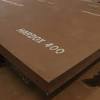Hardox 400 plate is a high-strength steel with excellent wear resistance, making it a favorite in many different fields and settings. The exceptional hardness of a Hardox 400 plate is the result of a careful quenching and tempering process. This steel plate has a nominal hardness of 400 HBW (Brinell Hardness), making it very impact- and wear-resistant. Its construction is geared toward withstanding severe circumstances and extending the useful life of parts that must endure erosion and abrasion.
A key factor in 400 plate's exceptional wear resistance is its high hardness, which makes it capable of withstanding the abrasion generated by rocks, minerals, ores, and other abrasive substances. Equipment and structures in the mining, construction, quarrying, agriculture, and recycling industries experience similar levels of wear and tear, so this material is ideal for use in these settings.
The use of the Hardox 400 plate is not without its potential downsides and restrictions. Some of them are listed below:
The enhanced hardness of the Hardox 400 stockist makes it quite brittle, even though it is a high-strength steel. This plate's hardness makes it exceptionally resistant to wear, but it also makes it more brittle than ordinary steel. This fragility increases the risk of cracking or breaking under stress, particularly in uses that subject the material to high-velocity impacts or other forms of dynamic loading.
The high hardness of the Hardox 400 makes it less malleable than milder steel. Bending, shaping, or cold forming the plate may be more difficult without the right tools or expertise. During the fabrication process, extreme care must be taken to prevent the material from deforming too much or cracking.
Although this plate is exceptionally wear-resistant, it has a relatively low resistance to impact pressures. It might get dented or smashed if you drop something heavy on it or if you put a lot of weight on it all at once. Other grades with greater toughness qualities may be preferable in uses where impact resistance is critical.
To avoid cracking or a decrease in mechanical qualities in the heat-affected zone, plate needs to be preheated and properly heat treated after welding. Expertise and strict adherence to welding methods are required for the successful joining of this high-strength steel.
Price: this is a high-end steel with superior wear resistance. For this reason, it typically costs more than mild or carbon steel. The higher price may be prohibitive for some low-budget projects or uses where durability against wear is secondary.
Keep in mind that these are issues unique to Hardox 400 plate, and evaluate them in light of the planned use and operating conditions.





Comments